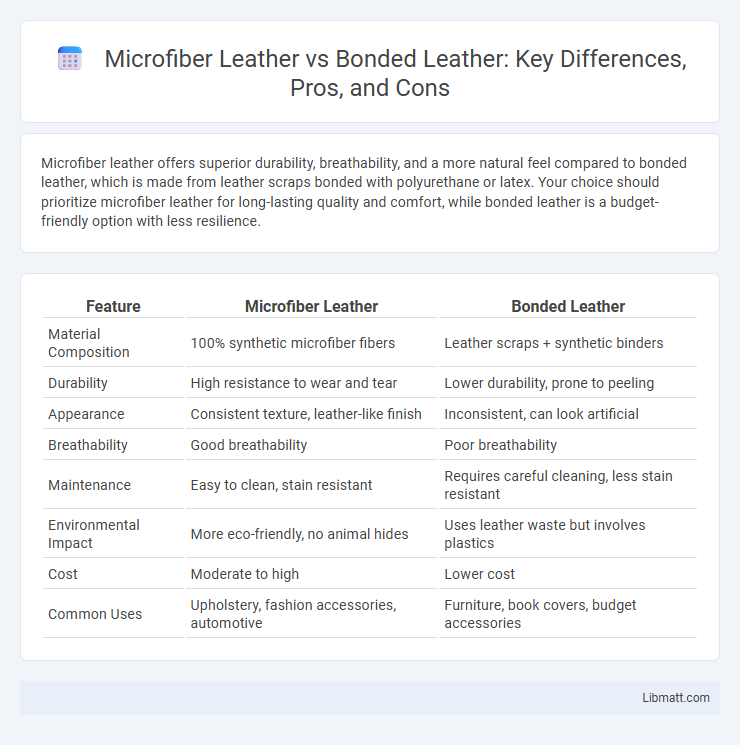Microfiber leather offers superior durability, breathability, and a more natural feel compared to bonded leather, which is made from leather scraps bonded with polyurethane or latex. Your choice should prioritize microfiber leather for long-lasting quality and comfort, while bonded leather is a budget-friendly option with less resilience.
Table of Comparison
| Feature | Microfiber Leather | Bonded Leather |
|---|---|---|
| Material Composition | 100% synthetic microfiber fibers | Leather scraps + synthetic binders |
| Durability | High resistance to wear and tear | Lower durability, prone to peeling |
| Appearance | Consistent texture, leather-like finish | Inconsistent, can look artificial |
| Breathability | Good breathability | Poor breathability |
| Maintenance | Easy to clean, stain resistant | Requires careful cleaning, less stain resistant |
| Environmental Impact | More eco-friendly, no animal hides | Uses leather waste but involves plastics |
| Cost | Moderate to high | Lower cost |
| Common Uses | Upholstery, fashion accessories, automotive | Furniture, book covers, budget accessories |
Overview: Microfiber Leather vs Bonded Leather
Microfiber leather is a synthetic material made from finely woven polyester fibers coated with polyurethane, offering durability, breathability, and a realistic leather appearance. Bonded leather consists of shredded genuine leather scraps mixed with polyurethane or latex, resulting in a less durable, less breathable material often used for budget-friendly furniture and accessories. Microfiber leather outperforms bonded leather in terms of longevity, resistance to wear, and ease of maintenance, making it a preferred choice for high-quality upholstery and fashion products.
Material Composition and Structure
Microfiber leather consists of ultra-fine synthetic fibers, primarily polyester and polyurethane, woven into a dense, durable fabric that mimics natural leather's texture and breathability. Bonded leather is created by combining shredded genuine leather scraps with a polyurethane or latex binder, then embossed to resemble full-grain leather, resulting in lower durability and less breathability. The tightly woven fibers in microfiber leather provide enhanced flexibility and resistance to wear, whereas bonded leather's composition leads to quicker degradation and peeling over time.
Manufacturing Processes
Microfiber leather is manufactured through a precise process combining ultrafine synthetic fibers with a polyurethane coating, resulting in a highly durable and breathable material that closely mimics genuine leather's texture. Bonded leather, on the other hand, is produced by shredding real leather scraps and bonding them with a polyurethane or latex backing, creating a composite material that is less durable and prone to degradation over time. The advanced manufacturing techniques of microfiber leather ensure greater uniformity and resilience compared to the more variable quality of bonded leather.
Durability and Longevity
Microfiber leather offers superior durability and longevity compared to bonded leather due to its synthetic fibers tightly woven to mimic real leather while resisting wear and tear. Bonded leather, made from leather scraps bonded with polyurethane, tends to peel and degrade faster under frequent use, reducing its lifespan. Your choice of microfiber leather ensures a longer-lasting, more resilient material ideal for furniture or accessories requiring sustained durability.
Appearance and Texture
Microfiber leather features a smooth, consistent texture that closely mimics genuine leather's natural grain and softness, offering a premium appearance ideal for upholstery and fashion. Bonded leather, composed of leather scraps bound with polyurethane, often displays a less uniform texture with visible imperfections and a synthetic feel, making it less durable and appealing over time. Your choice depends on whether you prioritize the realistic look and tactile quality of microfiber leather or the more economical, yet less refined, bonded leather.
Comfort and Breathability
Microfiber leather offers superior comfort and breathability due to its synthetic fiber composition, which allows for enhanced air circulation and moisture-wicking properties. Bonded leather, made from shredded leather scraps combined with adhesives, tends to be less breathable and can trap heat and moisture, leading to discomfort over prolonged use. The micro-porous structure of microfiber leather makes it a preferred choice for upholstery and apparel where comfort and ventilation are critical.
Environmental Impact
Microfiber leather offers a lower environmental impact compared to bonded leather by using synthetic fibers that reduce the need for animal hide and minimize waste. Bonded leather combines scraps of genuine leather with adhesives and synthetic materials, which can release volatile organic compounds (VOCs) during production and hinder recyclability. Microfiber leather's durability and resistance to water also extend product lifespan, contributing to decreased resource consumption and waste generation over time.
Maintenance and Care
Microfiber leather requires minimal maintenance, needing only regular dusting and occasional wiping with a damp cloth to preserve its durability and appearance. Bonded leather demands more attentive care, as it is prone to peeling and cracking, necessitating the use of leather conditioners and avoiding excessive moisture. Both materials benefit from avoiding direct sunlight and sharp objects to extend their lifespan and maintain their surface quality.
Cost Comparison
Microfiber leather typically costs more than bonded leather due to its advanced manufacturing process and superior durability. Bonded leather is often cheaper because it is made by blending shredded leather scraps with polyurethane or latex, resulting in lower material and production expenses. Consumers seeking long-lasting upholstery may find microfiber leather a better investment despite the higher initial price.
Best Uses and Applications
Microfiber leather excels in automotive upholstery, high-end furniture, and fashion accessories due to its durability, breathability, and resistance to wear and staining. Bonded leather is best suited for budget-friendly furniture and decorative pieces where the authentic leather look is desired but less durability is required. Your choice depends on whether you prioritize long-lasting performance or cost-effective aesthetics.
Microfiber leather vs bonded leather Infographic

 libmatt.com
libmatt.com